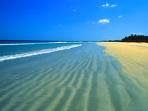
The finishing village 116 kms. from Colombo is considered to be best for surfing in Sri lanka. The beach is also good for swimming. Wild elephants can be sighted from the "Crocodile Rock".
The sun shining beaches of Sri Lanka are aound the island as seen from the map. The seas are warm. The west coast and southern beaches are best from October to March. The East coast beaches are best during march and October.



